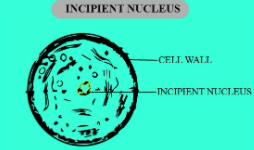
Answer
462.9k+ views
Hint: It is present in the prokaryotic organisms, which include the blue-green algae and is found in the damp terrestrial or aquatic region.
Complete Answer:
Myxophyceae is a class of algae which is now called cyanobacteria and is commonly known as blue-green algae. The incipient nucleus is not a true nucleus and is also known as a nucleoid, it is found in prokaryotes. The group Myxophyceae comes under prokaryotes.
Additional information:
-The incipient nucleus is the immature nucleus of prokaryotes.
-The nucleoid is not double membranous and is not fully developed.
-The incipient nucleus is the precursor of the eukaryotic nucleus from which it is developed.
-The incipient nucleus is made up of a circular double-stranded DNA.
-The DNA of the incipient nucleus does not condense and is not organized in the form of chromosomes.
-The DNA is present in a dense form in the center of the cell.
-It is irregular in the shaped nucleus without any histone proteins.
-It is commonly found in bacteria.
-The centroplasm represents the nucleus sometimes.
-Centroplasm is the colorless inner region of the cytoplasm which contains the nuclear body.

So, the correct answer is ‘Myxophyceae’.
Note: The Myxophyceae (Cyanophyceae) consists of free-living photosynthetic bacteria and endosymbiotic plastids. They are capable of natural genetic transformation. They are sometimes sold as food containing substances like amino acids, fatty acids, proteins, vitamins, minerals, pigments, etc. Chlorophyceae is also called green algae, due to the presence of the chlorophyll pigment. Rhodophyceae is also known as red algae because of the presence of phycoerythrin pigment. Phaeophyceae is also known as the brown algae, it is due to the presence of fucoxanthin pigment.
Complete Answer:
Myxophyceae is a class of algae which is now called cyanobacteria and is commonly known as blue-green algae. The incipient nucleus is not a true nucleus and is also known as a nucleoid, it is found in prokaryotes. The group Myxophyceae comes under prokaryotes.
Additional information:
-The incipient nucleus is the immature nucleus of prokaryotes.
-The nucleoid is not double membranous and is not fully developed.
-The incipient nucleus is the precursor of the eukaryotic nucleus from which it is developed.
-The incipient nucleus is made up of a circular double-stranded DNA.
-The DNA of the incipient nucleus does not condense and is not organized in the form of chromosomes.
-The DNA is present in a dense form in the center of the cell.
-It is irregular in the shaped nucleus without any histone proteins.
-It is commonly found in bacteria.
-The centroplasm represents the nucleus sometimes.
-Centroplasm is the colorless inner region of the cytoplasm which contains the nuclear body.

So, the correct answer is ‘Myxophyceae’.
Note: The Myxophyceae (Cyanophyceae) consists of free-living photosynthetic bacteria and endosymbiotic plastids. They are capable of natural genetic transformation. They are sometimes sold as food containing substances like amino acids, fatty acids, proteins, vitamins, minerals, pigments, etc. Chlorophyceae is also called green algae, due to the presence of the chlorophyll pigment. Rhodophyceae is also known as red algae because of the presence of phycoerythrin pigment. Phaeophyceae is also known as the brown algae, it is due to the presence of fucoxanthin pigment.
Recently Updated Pages
Who among the following was the religious guru of class 7 social science CBSE

what is the correct chronological order of the following class 10 social science CBSE

Which of the following was not the actual cause for class 10 social science CBSE

Which of the following statements is not correct A class 10 social science CBSE

Which of the following leaders was not present in the class 10 social science CBSE

Garampani Sanctuary is located at A Diphu Assam B Gangtok class 10 social science CBSE

Trending doubts
A rainbow has circular shape because A The earth is class 11 physics CBSE

Which are the Top 10 Largest Countries of the World?

Fill the blanks with the suitable prepositions 1 The class 9 english CBSE

How do you graph the function fx 4x class 9 maths CBSE

The Equation xxx + 2 is Satisfied when x is Equal to Class 10 Maths

Which is the first open university in India A Andhra class 10 physics CBSE

Difference between Prokaryotic cell and Eukaryotic class 11 biology CBSE

Give 10 examples for herbs , shrubs , climbers , creepers

Change the following sentences into negative and interrogative class 10 english CBSE




